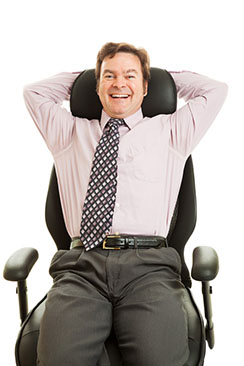Getting Ergonomic at Work: Critical Health Safety and Productivity Factors
By Julie King | July 14, 2013
 Many of us spend a lot of time at our desks each day. Yet the human form was not designed for prolonged periods of sitting.
Many of us spend a lot of time at our desks each day. Yet the human form was not designed for prolonged periods of sitting.
New research is uncovering interesting nuances to ergonomics in the workplace that go beyond the type of furniture to purchase. A shift to standing desks or having employees sit on a large, inflated ball may be better than the best ergonomic chair and desk combos.
Here is what business owners and managers need to know when shopping for ergonomic workplace furniture.
Prolonged sitting can create serious health risks
Research from the University of Sydney found a link between sitting time was responsible for 6.9 per cent of deaths and could be established regardless of gender, age, how physically active a person was and body mass index.
An ongoing study is probing the value of using standing desks at work and preliminary findings indicate that using a standing desk for half of an eight hour work day may help off-set the risk created by prolonged sitting.
Furniture style may encourage dishonesty
What's more, even the style of furniture used can have an impact at work, only this may be on your employees' attitudes and the honesty of their behaviour, rather than their physique.
Recent research led by Andy Yap of the Massachusetts Institute of Technology (MIT) found a correlation between dishonest behaviour and whether the furniture created an expansive or contractive posture.
In plain language, people in the study who used furniture designed to create an expansive body position of power, whether intentional or inadvertent, were more likely to cheat, steal or commit a traffic violation than those who used furniture that encouraged a contractive body position.
There is a correlation to size, because larger desks and chair encourage expansive posture. This idea is explored in more depth by Amy Cuddy in her TED talk, Your body language shapes who you are.
Ergonomic furniture selection essentials
Of course, good positioning in tradition office furniture is still important. An earlier article on CanadaOne outlined six safety factors to consider to help reduce musculoskeletal disorders among computer users (almost all of us). Here are the six factors as recommended by Anthro Technology Furniture® from the original CanadaOne article, Getting Ergonomic:
A Perfect Fit. Most desks and tables are around 29 inches high, which is great for doing paperwork or writing. It's too high, though, for keyboarding (the ideal is 23-27 inches) and too low for a monitor, which should be at eye level. Reaching for a too-high keyboard leads to wrist pain, and dropping the head forward to view a too-low monitor strains neck muscles. The Tall and Short of it. A perfect fit for one employee may be a dangerous misfit for another. Computers and other hardware that are shared by employees of various heights should be supported on an adjustable-height keyboard and mouse tray. Folks can then easily raise or lower the keyboard into a comfortable position, and choose to sit or stand while inputting information. Up and Down and All Around. For high-tech equipment on the move, mobile carts must have, at a minimum, firmly fastened castors, which glide smoothly and lock securely. Handles and safety straps make it easier still to careen down corridors, across parking lots, and over elevator thresholds. Sitting Pretty. Chairs should have a backrest, swivel base, and rolling castors. They should also offer adjustment for the seat, back, and height. (If raising the height lifts feet off the floor, add a footrest.) For perfect posture, employees should be trained to make use of the adjustment points on their chairs and computer furniture. Shed light on the situation. Cut glare on monitor screens by relying on indirect light, which is kindest to eyes. Turn off harsh overhead lights. Close curtains or blinds. Position monitors so windows are to the side of or behind the screen. Then, use a desk or clamp-on lamp to illuminate small areas. The Cutting Edge. Make sure that computer furniture shelf edges are smooth and rounded, with no sharp corners. Shake stands vigorously to be sure they're stable enough to hold heavy hardware – especially if in motion.




